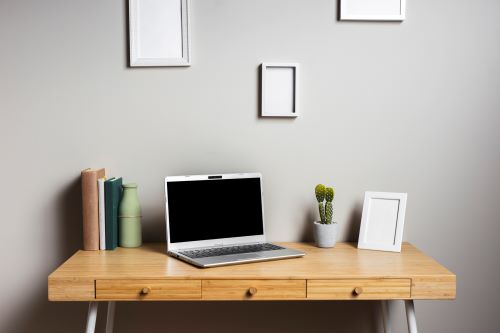Working from home has become part of the ‘new normal’. While it might have been convenient to simply open your laptop at the dining table or in front of the TV, having a dedicated work area is more productive.
Provided you have the space, a home office is relatively easy to set up and is well worth the initial time and financial investment. So, how do you set up a home office? Here are the things you need to consider.
So, how do you set up a home office? Here are the things you need to consider.
Assessing space
When setting up a home office, the first crucial step is to assess the available space in your home. This process involves more than just picking a quiet corner; it is about finding a balance between convenience and functionality.
For many Australians, space is at a premium, so it’s essential to be strategic. Consider underutilised areas: perhaps a guest room that’s rarely occupied, or a section of your living room that you can partition off.
The key is to choose a spot that minimises household distractions and maximises your focus. Remember, clever design choices can transform even the most minimal space into an efficient work area.
Natural light, away from the hustle and bustle of family life, and sufficient room for essential furniture are all important factors. This initial step of assessing your available space lays the groundwork for creating a practical and comfortable home office that caters to your professional needs.
Essential home office furniture
Choosing the right furniture is pivotal for any effective home office. Start with the desk; it’s the centrepiece of your work environment. You’ll find various options in the Australian market, from spacious executive desks to compact corner units catering to different space requirements.
Select a desk that provides ample room for your daily tasks and fits comfortably in your allocated space. Next, consider storage solutions like shelves or filing cabinets to keep your workspace organised and clutter-free. A well-organised office promotes efficiency and reduces stress. Don’t forget the importance of a reliable office chair.
It should be comfortable, supportive, and adjustable, allowing you to work for extended periods without discomfort. The best furniture not only adds functionality to your home office but also reflects your individual style, making your work area a place where you enjoy spending time.
Ergonomics
Integrating ergonomics into your home office set up is essential for maintaining comfort and avoiding strain or injury. Start with your chair; it should support your lower back and allow your feet to rest flat on the floor, with thighs parallel to the ground.
The height of your desk is equally important. When seated, your arms should be at a right angle while typing, preventing wrist strain. Monitor placement is another crucial aspect of ergonomics – the top of the screen should be at or slightly below eye level and an arm’s length away, reducing neck strain and eye fatigue.
Consider accessories such as a keyboard tray or an ergonomic mouse to further enhance your comfort. Remember that in an ergonomic home office, each element should work together to support your body’s natural posture, promoting health and productivity in your workday.
Getting the technology right
Setting up the technological aspects of your home office is a critical step in ensuring a seamless work experience. Begin by ensuring you have a robust internet connection, the backbone of most modern home offices.
It’s vital to consult a professional to properly install data points and wall plates, ensuring your internet and power sources are conveniently and safely located. Consider your computer placement for optimal comfort and efficiency.
Don’t overlook the importance of peripheral devices such as printers, scanners, and external hard drives, which should be easily accessible but not clutter your workspace. Managing cords and cables neatly can also help maintain an organised and hazard-free office space.
Investing time and thought into setting up your technology correctly pays off in the long run, as it enhances productivity and reduces unnecessary stress.
Lighting and ambiance
Lighting and ambience play a significant role in creating a productive and comfortable home office environment. Proper lighting, particularly natural light, can boost your mood and reduce eye strain.
Position your desk near a window if possible, but also invest in quality artificial lighting for those gloomier days or evening work. When it comes to ambience, consider the aesthetics of your workspace.
A neutral wall colour is necessary for those conducting online meetings; it provides viewers with a professional, distraction-free background. This doesn’t mean your office should be devoid of personality. Add elements that inspire you, like artwork, plants, or personal items, but keep them tasteful and not overly distracting. The goal is to create a space that functions well, feels inviting, and stimulates your creativity and focus.
The power of organisation
Effective organisation is vital to maintaining productivity and efficiency in a home office. Start by choosing the right tools that cater to your work needs and personal style.
Use desk organisers to keep your office supplies tidy and within reach. Investing in a practical filing system, whether traditional filing cabinets or digital organisation software, can significantly enhance your ability to locate important documents and quickly reduce clutter.
Don’t underestimate the power of label makers and storage bins to keep everything in its rightful place. Additionally, consider using digital tools and apps for task management and scheduling to keep track of your projects and deadlines. Remember, a well-organised workspace can significantly reduce stress and save time, allowing you to focus more on your work and less on searching for misplaced items.
Staying connected
Staying connected is vital in a home office, especially when you’re working remotely. Today, numerous tools and technologies are at your disposal to help maintain effective communication with your colleagues and clients.
Start by ensuring you have a reliable video conferencing set up, which includes a good quality webcam and microphone for clear and professional virtual meetings. Utilise collaborative online tools like Slack, Microsoft Teams, or Asana for team communication and project management, allowing for real-time updates and collaboration.
Regular check-ins and virtual meetings help maintain a sense of team cohesion and ensure everyone is aligned on their goals. Despite working apart, these tools can help bridge the gap, ensuring you remain an integral part of your team and maintain strong professional relationships.
Crafting your ideal home office
Setting up a great home office is all about combining practicality with personal style. Each element plays a critical role in crafting a productive work environment, from selecting the suitable space and essential furniture, to ensuring ergonomic comfort to setting up efficient technology and lighting.
Remember that your home office is more than just a physical space; it reflects your professional identity and is a catalyst for your productivity and creativity.
“The opinions expressed by BizWitty Contributors are their own, not those of BizCover and should not be relied upon in place of appropriate professional advice. Please read our full disclaimer."







